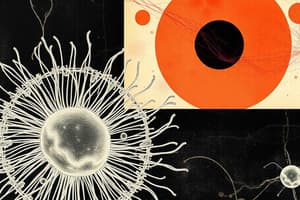Podcast
Questions and Answers
What is the study of the tissues of the body called?
What is the study of the tissues of the body called?
Histology
Which of the following statements about cells is true?
Which of the following statements about cells is true?
- Cells have varied shapes and sizes. (correct)
- Cells do not share any common features.
- All living organisms are formed of tissues.
- The nucleus is not present in living cells.
The plasma membrane can be seen with a light microscope.
The plasma membrane can be seen with a light microscope.
False (B)
The cell membrane is primarily made up of __________.
The cell membrane is primarily made up of __________.
What type of proteins are embedded within the lipid bilayer of the cell membrane?
What type of proteins are embedded within the lipid bilayer of the cell membrane?
What are the two types of cell organoids?
What are the two types of cell organoids?
Rough endoplasmic reticulum has ribosomes on its surface.
Rough endoplasmic reticulum has ribosomes on its surface.
Which of the following is a function of the smooth endoplasmic reticulum (SER)?
Which of the following is a function of the smooth endoplasmic reticulum (SER)?
Flashcards are hidden until you start studying
Study Notes
The Cell Structure
- The cell is the basic unit of life, and all living organisms are composed of cells.
- Cells vary in size, shape, and function, but they share common features.
The Plasma Membrane
- The plasma membrane is the outer boundary of the cell, and it regulates what enters and exits the cell.
- It's composed of lipids, proteins, and carbohydrates.
The Plasma Membrane Structure
- The lipid bilayer is composed of phospholipids with their hydrophobic tails facing inwards and hydrophilic heads facing outwards.
- Cholesterol is embedded within the lipid bilayer.
- Two types of proteins are present: integral proteins embedded within the bilayer and peripheral proteins associated with the inner layer.
- Carbohydrates are attached to both proteins and lipids, forming glycoproteins and glycolipids respectively.
The Glycocalyx
- The glycocalyx is a delicate coating on the outer surface of the plasma membrane.
- It's composed of oligosaccharide chains attached to protein and lipid components.
- The glycocalyx plays a role in cell protection, recognition, antigenicity, and filtration.
The Cytoplasm
- The cytoplasm is a heterogeneous substance containing various suspended particles.
Cell Organoids
- Organelles are specialized structures within the cytoplasm that perform specific functions.
- They are classified as membranous and non-membranous.
Membranous Organelles
- Membranous organelles are enclosed by a membrane.
- Examples include the endoplasmic reticulum, Golgi apparatus, lysosomes, mitochondria, secretory vesicles, and coated vesicles.
The Endoplasmic Reticulum (ER)
- The ER is a network of interconnected intracellular membranes.
- Two types of ER exist: rough ER (RER) and smooth ER (SER).
Rough Endoplasmic Reticulum (RER)
- RER has ribosomes attached to its membrane.
- It appears as stacked flattened cisternae.
- Its primary function is protein synthesis for export.
Smooth Endoplasmic Reticulum (SER)
- SER lacks ribosomes.
- It appears as membrane-bound tubules and vesicles.
- SER plays various roles, including lipid synthesis (especially steroids), mineral metabolism (formation of HCl), detoxification of toxins, and muscle contraction.
Studying That Suits You
Use AI to generate personalized quizzes and flashcards to suit your learning preferences.




